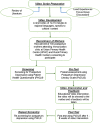Study on awareness and management based health action using video intervention (SAMBHAV) for postpartum depression among mothers attending immunisation clinic in a tertiary medical college hospital: Study protocol
- PMID: 38568902
- PMCID: PMC10990171
- DOI: 10.1371/journal.pone.0301357
Study on awareness and management based health action using video intervention (SAMBHAV) for postpartum depression among mothers attending immunisation clinic in a tertiary medical college hospital: Study protocol
Abstract
Introduction: Pregnancy exerts a detrimental effect on women's mental health. Maternal mental health is considered as one of the public health concerns as it impacts the health of both mother and the child. One in five people in developing countries experience serious mental health issues during pregnancy and after giving birth. In India, postpartum depression (PPD) affects 22% of women, according to a research by WHO. The available data on mental health literacy among women, showed that only 50.7% of the postpartum mothers who were attending paediatric tertiary care centres had adequate knowledge about PPD. It is crucial to diagnose early and adequately manage postpartum depression to avoid long-term consequences. It is also essential to seek help and utilise the available resources and services to avoid worsening of the condition and to aid in the recovery. This demonstrates the need to promote awareness, improve help seeking, reduce stigma and treatment gap associated with PPD through educational video intervention specific to cultural context and beliefs.
Materials and methods: This is a quasi-experimental study without a control group that attempts to improve the awareness among the mothers about postpartum depression to understand better about the condition and also its management through video intervention. The video intervention will be developed in regional language specific to the cultural context of the setting. The video script will be finalised from the findings of the available literature and also through focus group discussion among mothers and health care professionals which will be analysed qualitatively using thematic identification. The study will use a standardized Postpartum Depression Literacy Scale (PoDLIS) which will be quantitatively analysed using paired t test before and after the intervention. Repeated measures of ANOVA will also be used to analyse the changes in literacy scale scores with respect to socio demographic variables. The mothers will also be screened for PPD using Patient Health Questionnaire 9 (PHQ 9) and feedback will be collected and analysed to find the overall usefulness of video.
Discussion: If it becomes apparent that this video intervention is successful in raising awareness of PPD among postpartum mothers and reducing stigma, it can be used to aid early identification of mothers with PPD which can result in early management and improved health outcome for both mothers and children. The major goals of the video intervention are to raise awareness, lessen stigma, and prevent PPD through strong family support, adopting healthy lifestyles, having access to information, practising self-care, and enhancing help-seeking.
Trial registration: The trial is registered under the Clinical Trial Registry- India (CTRI) (CTRI/2023/03/050836). The current study adheres to the SPIRIT Guidelines [See S1 Checklist: SPIRIT Guidelines].
Copyright: © 2024 K. et al. This is an open access article distributed under the terms of the Creative Commons Attribution License, which permits unrestricted use, distribution, and reproduction in any medium, provided the original author and source are credited.
Conflict of interest statement
The authors have declared that no competing interests exist.
Figures
Similar articles
-
Online and Offline Intervention for the Prevention of Postpartum Depression among Rural-to-Urban Floating Women: Study Protocol for a Randomized Control Trial.Int J Environ Res Public Health. 2022 Jun 29;19(13):7951. doi: 10.3390/ijerph19137951. Int J Environ Res Public Health. 2022. PMID: 35805609 Free PMC article.
-
Impact of an educational intervention on improving maternity nurses' knowledge and attitudes toward postpartum depression: a quasi-experimental study.J Med Life. 2024 Aug;17(8):782-790. doi: 10.25122/jml-2024-0147. J Med Life. 2024. PMID: 39539432 Free PMC article.
-
India's Silent Struggle: A Scoping Review on Postpartum Depression in the Land of a Billion Mothers.Indian J Psychol Med. 2025 May;47(3):207-213. doi: 10.1177/02537176241245773. Epub 2024 May 13. Indian J Psychol Med. 2025. PMID: 39564219 Free PMC article. Review.
-
Treatment gap and help-seeking for postpartum depression in a rural African setting.BMC Psychiatry. 2016 Jun 10;16:196. doi: 10.1186/s12888-016-0892-8. BMC Psychiatry. 2016. PMID: 27287387 Free PMC article.
-
Screening for depression and help-seeking in postpartum women during well-baby pediatric visits: an integrated review.J Pediatr Health Care. 2012 Mar;26(2):109-17. doi: 10.1016/j.pedhc.2010.06.012. Epub 2010 Aug 11. J Pediatr Health Care. 2012. PMID: 22360930 Review.
References
-
- Mughal S, Azhar Y, Siddiqui W. Postpartum Depression. In: StatPearls [Internet]. Treasure Island (FL): StatPearls Publishing; 2023. [cited 2023 Apr 22]. http://www.ncbi.nlm.nih.gov/books/NBK519070/
-
- Zauderer C. Postpartum Depression: How Childbirth Educators Can Help Break the Silence. J Perinat Educ [Internet]. 2009. [cited 2023 May 15];18(2):23–31. Available from: https://www.ncbi.nlm.nih.gov/pmc/articles/PMC2684038/ doi: 10.1624/105812409X426305 - DOI - PMC - PubMed
-
- Wednesday JNH|, May 6, 2020. Blog: Maternal Mental Health Awareness Week reminds us to reach out to the mothers in our lives [Internet]. Input Fort Wayne. [cited 2023 Apr 22]. https://www.inputfortwayne.com/features/maternal-mental-health.aspx
-
- Maternal mental health [Internet]. [cited 2023 Apr 22]. https://www.who.int/teams/mental-health-and-substance-use/promotion-prev...
-
- Agarwala A, Arathi Rao P, Narayanan P. Prevalence and predictors of postpartum depression among mothers in the rural areas of Udupi Taluk, Karnataka, India: A cross-sectional study. Clin Epidemiol Glob Health [Internet]. 2019. Sep [cited 2023 Apr 22];7(3):342–5. Available from: https://linkinghub.elsevier.com/retrieve/pii/S221339841830006X
Publication types
MeSH terms
LinkOut - more resources
Full Text Sources
Medical
Miscellaneous


